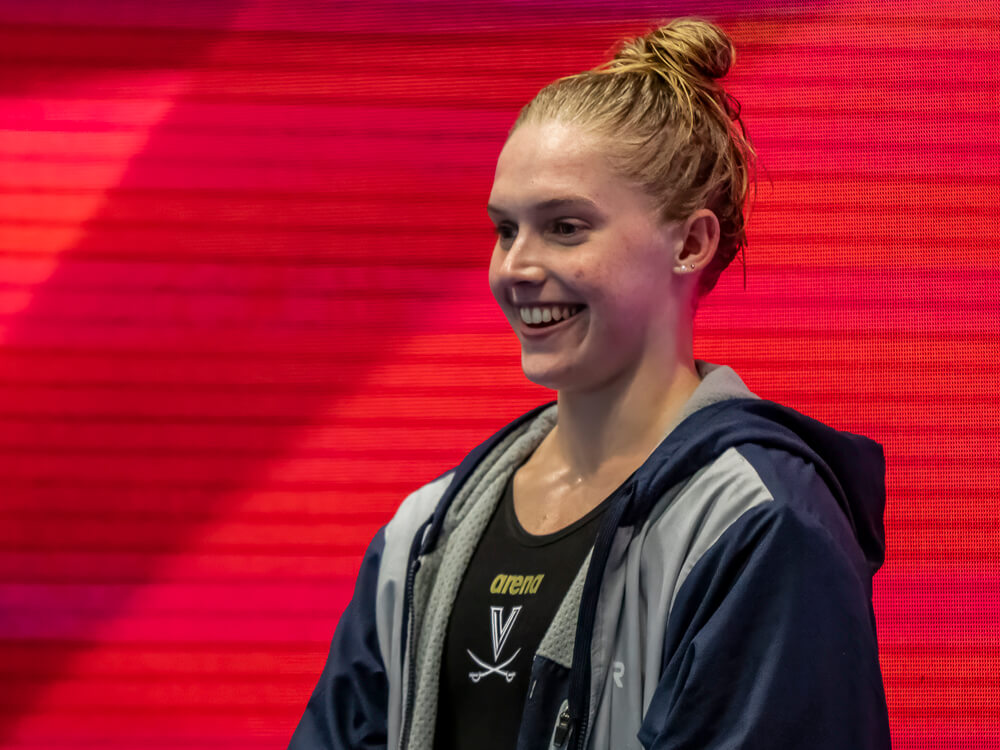A Look at the NIL Landscape in Swimming
The NCAA approved Name, Image, and Likeness compensation in 2021, opening the door for collegiate athletes to earn money through endorsements and sponsorships. When it comes to NIL, football and basketball dominate the headlines. Swimming, on the other hand, does not receive that same attention. Still, the sport is beginning to make waves in the NIL market as Olympians and NCAA champions continue to land partnerships.
The NCAA’s NIL Data Dashboard shows that top revenue sports still dominate the market share. As a non-revenue sport, swimming clearly lags in both deal counts and dollars per athlete. That said, swimmers are not entirely left out. Many are securing smaller, yet meaningful partnerships, often with swimwear brands or local businesses, while a few standouts earn larger contracts thanks to their accomplishments.
A Wide Gap
Football accounts for 41.6 percent of reported NIL deals in 2025, keeping the sport king in revenue. Swimming, by comparison, is listed under “other,” which makes up 9.7 percent. Swimmers are only a fraction of that 9.7 percent, highlighting just how limited their share of the NIL landscape really is.
In the NCAA NIL Dashboard, the 2025 revenue share includes men’s and women’s collegiate swimming combined. The average total earnings for a swimmer are $514, while the median athlete earnings are just $50. For comparison, football’s average athlete earnings are $38,476, with a median of $1,734. The numbers illustrate just how large the gap is between the revenue sports and swimming.
Limited Exposure, Limited Deals
Swimming has a smaller share of NIL money because of the sport’s limited exposure. College swimming rarely draws major media coverage other than the Olympics, World Championships and NCAA Championships. That leaves swimmers without the visibility or platforms that act as the catalyst for deals in football.
In the swimming world, NIL agreements often cover daily needs rather than life-changing income, such as grocery money or travel expenses. A majority of NIL deals in swimming come from swim-specific brands or local businesses. They provide meaningful support for swimmers, but it is not the type of income that will change an athlete’s financial future.
Looking Ahead
When talking about swimming and NIL, it is important to look to the future. NIL will not affect the sport in the same way it has with football. Olympic years and NCAA championships are essential for boosting attention to swimmers, giving the stars in this sport their chance in the spotlight. Those moments can lead to larger contracts, but for most swimmers, NIL will remain a source of practical help rather than serve as a life-changer. Until swimming becomes a constant in major media, the financial gap between it and high revenue sports will continue to grow.
Gretchen Walsh’s Success
Photo Courtesy: Jaylynn Nash/ACC
One swimmer who set the standard for what a top NIL earner can be is Gretchen Walsh. Her success in NIL was fueled by her dominance in the pool. While at the University of Virginia, she won multiple NCAA titles and set records in several events, including the 50-yard freestyle, 100-yard freestyle and 100-yard butterfly. She also carried that success onto the international stage, where she was the 2024 Olympic silver medalist in the 100 butterfly and the 2025 world champion in the 50 butterfly and 100 fly.
Her partnerships set an example of how a collegiate swimmer can grow a personal brand. Walsh has deals with Arena and Celsius, and she even launched her own co-branded swimwear line through Sporti. These are the prime opportunities available to collegiate swimmers. It is evident that success in the water goes hand in hand with success in NIL deals.
Examples in the Pool Today
Claire Curzan is a name to know in the NIL space. After transferring from Stanford to the University of Virginia in 2023, she maintained her status as an elite performer in the sport. She signed a deal with Crocs in 2023 and added a partnership with New Era in April 2025. There is a common denominator between Curzan and Walsh: success in the sport and a reliance on social media income. Their NIL earnings come less from straight cash contracts and more from promoting products through their online platforms.
To highlight the importance of social media for these deals, Isabella Smith serves as a strong example. Smith is a diver at Indiana University-Purdue University Indianapolis with a powerful social media reach. With more than 230,000 followers on TikTok, she has opened the door to opportunities to earn money in a non-revenue collegiate sport like swimming and diving. Because of her social media presence, she has a profile on Opendorse where she lists rates for social media posts, shoutouts and even autographs. Opendorse works as a marketplace, helping athletes promote themselves and making sure any agreements meet NCAA guidelines. To give an idea, Smith’s prices start at $627 for a social media post, $142 for a shoutout, and $45 for an autograph. Those numbers may seem small compared with revenue-sports athletes, but they still give athletes valuable opportunities to earn money.
Swimming’s Lane Forward
The reality of NIL in swimming is that the money remains small in comparison to major sports. Most swimmers only see modest earnings to help with daily expenses. The equalizer to this is social media. Social media is providing swimmers the chance to build their personal brands and secure deals that go beyond the pool. As these platforms continue to grow, so does the revenue a swimmer can earn. The key is developing a presence online and using major events like the Olympics and NCAA championships to spotlight the stars of the sport. Social media can be the avenue that turns small NIL checks into bigger opportunities for swimmers in the future. The race for NIL opportunities starts in the water, but ends with a swimmer’s personal brand.
